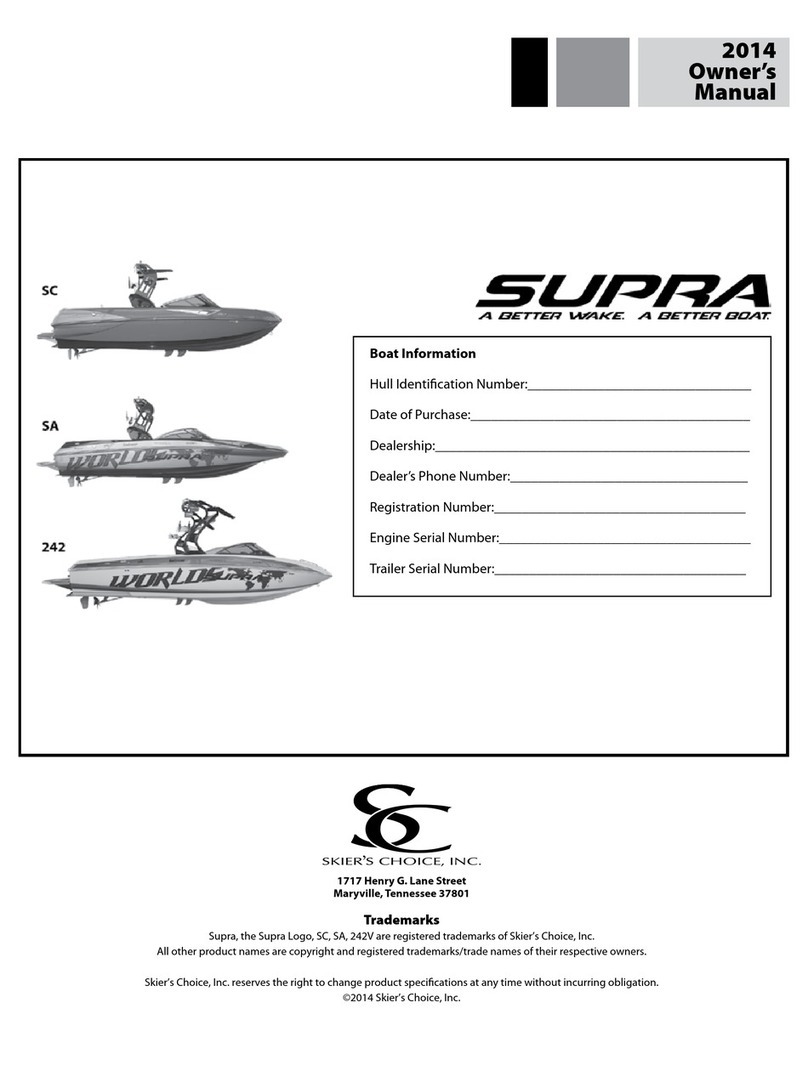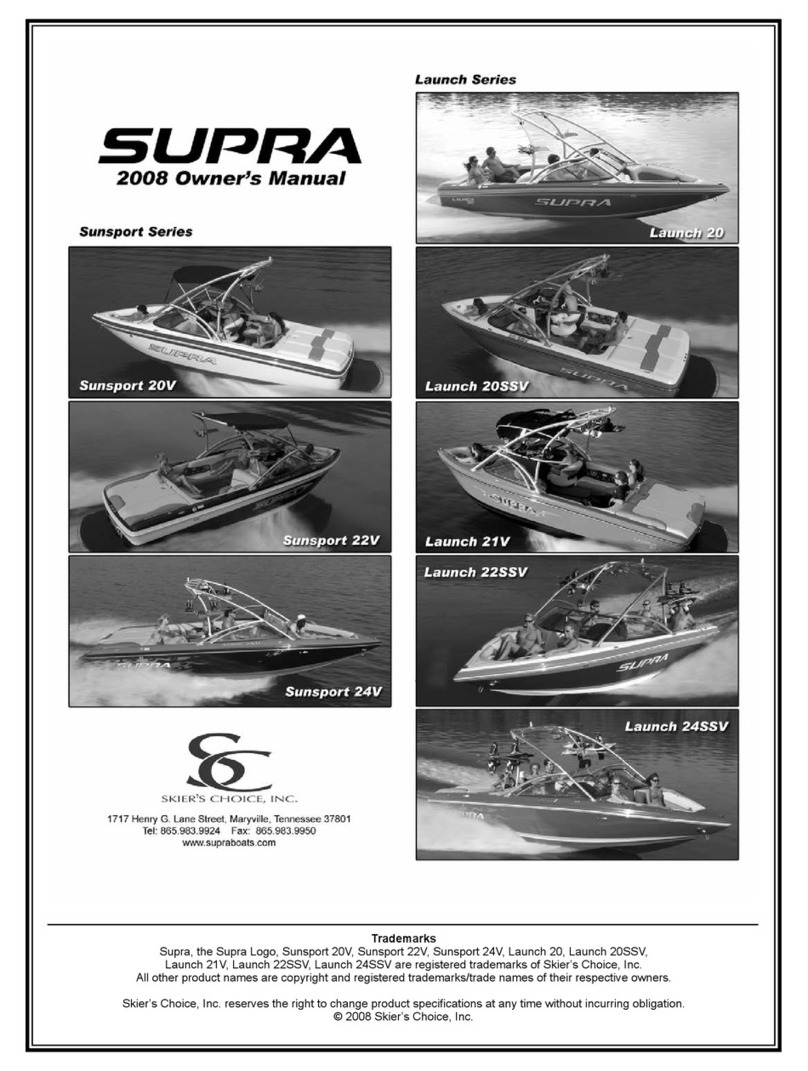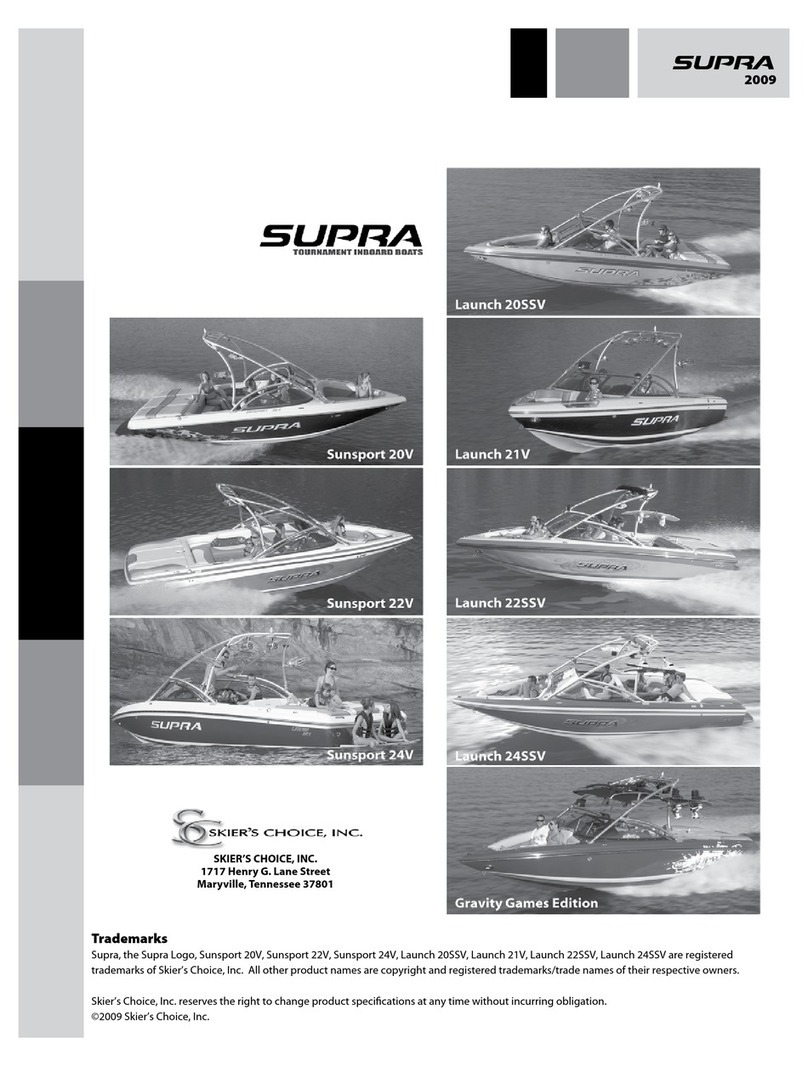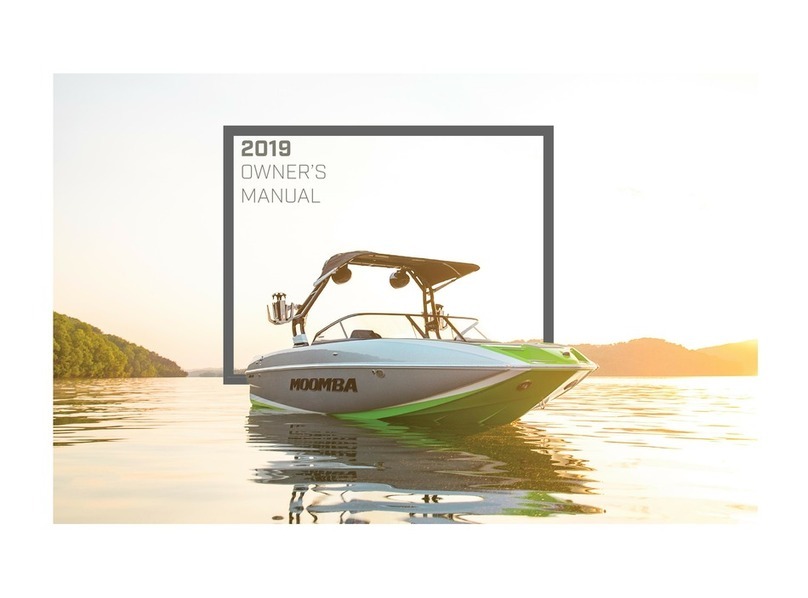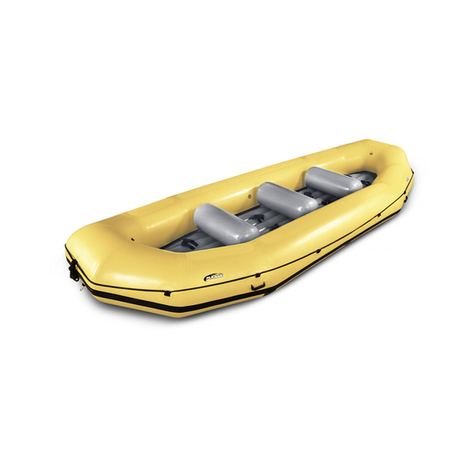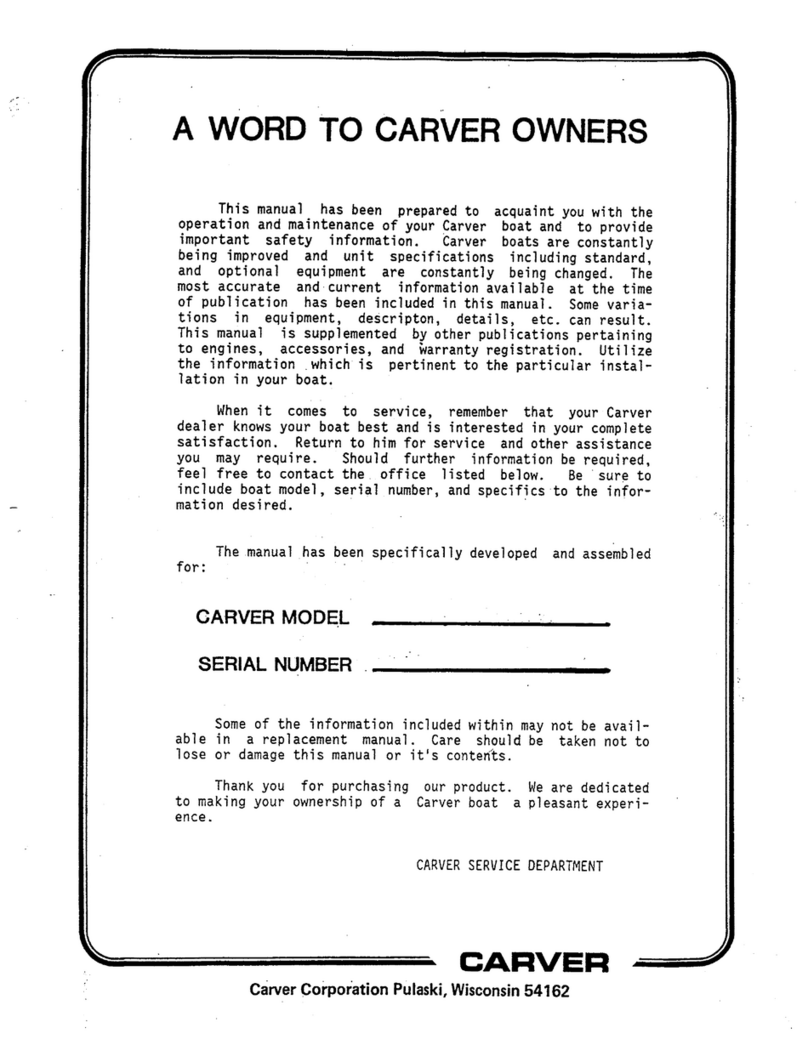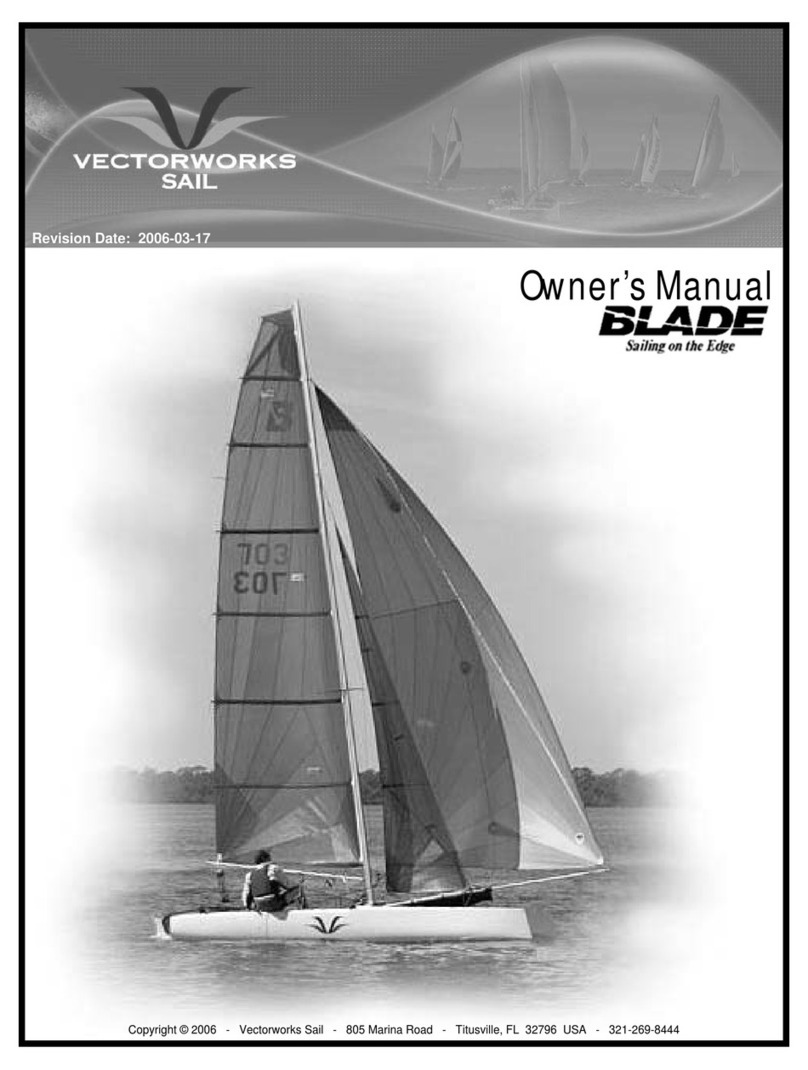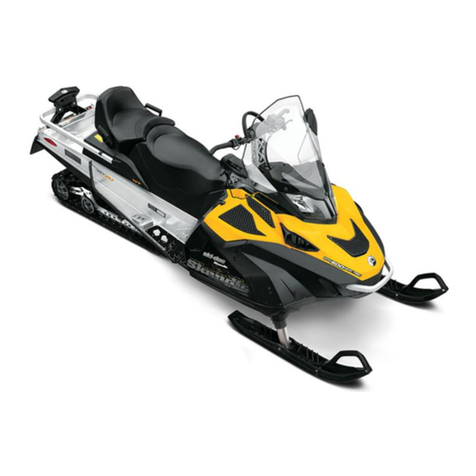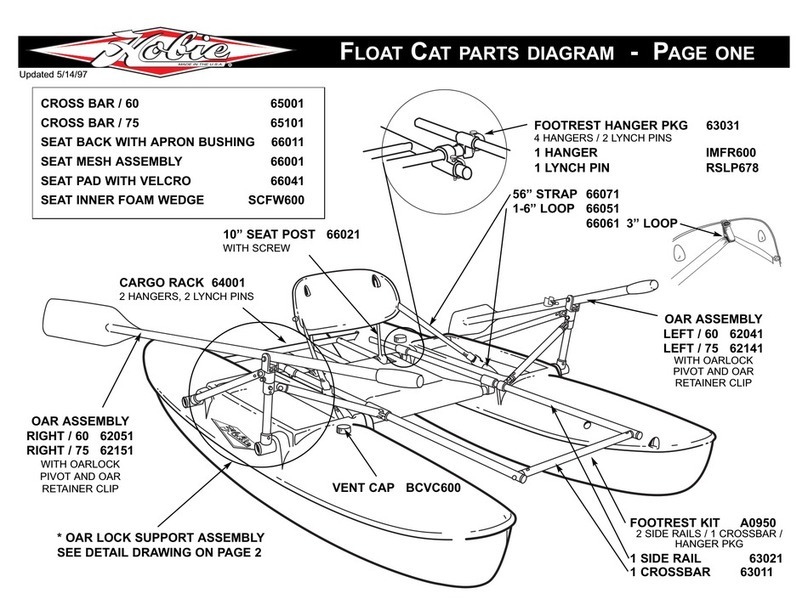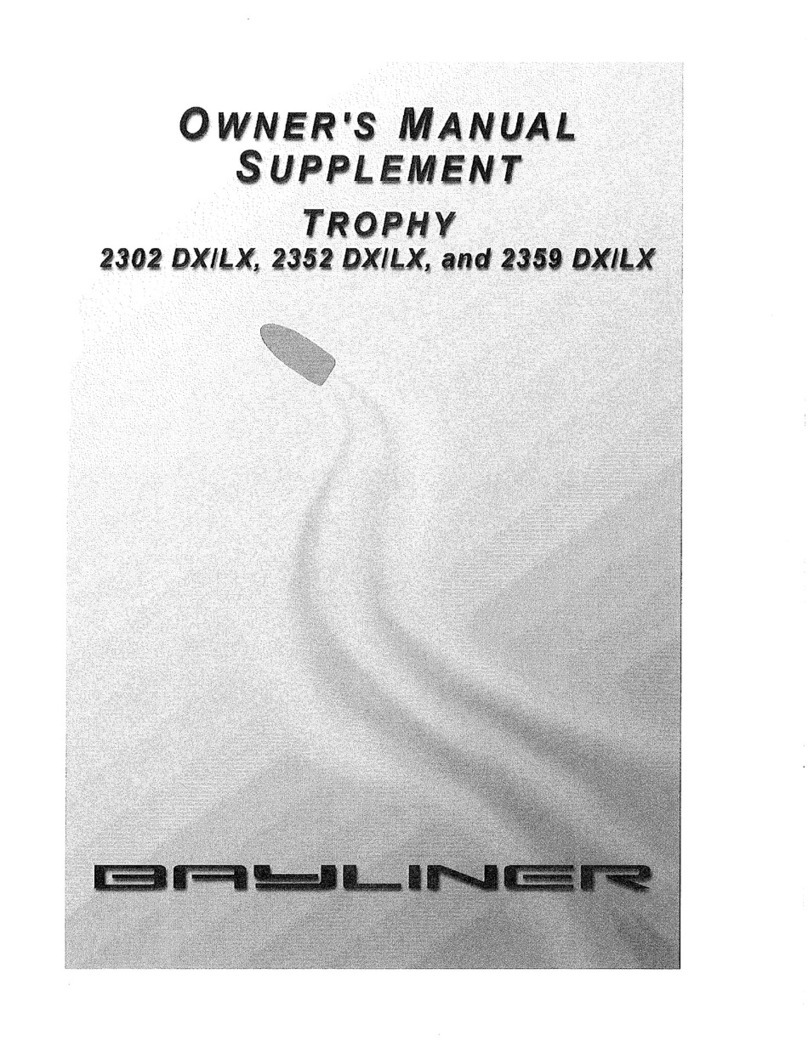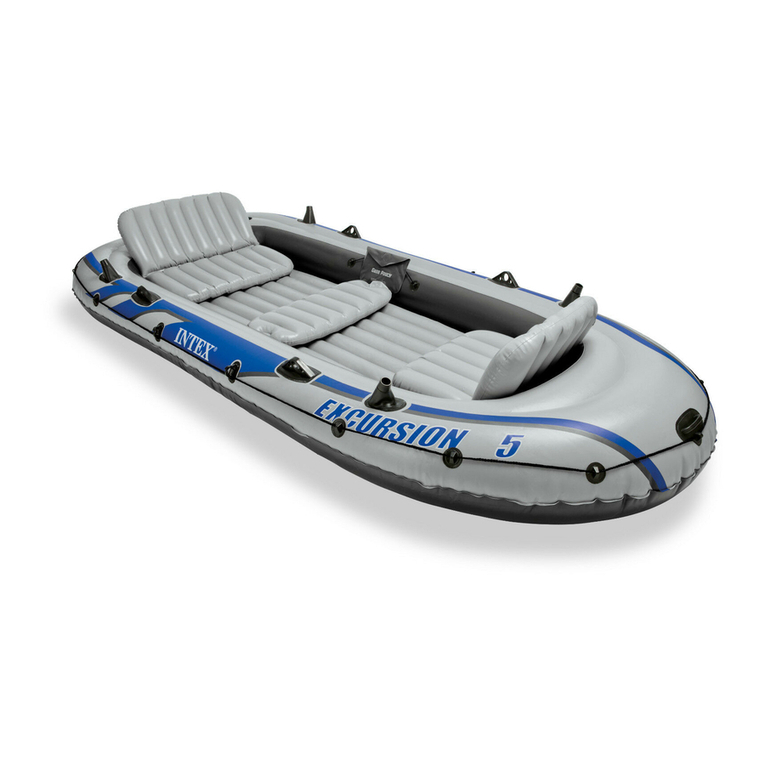Skier's Choice Moomba User manual

Pg 1
Pg
1
2024
Owner’s Manual

Pg 3
CONGRATULATIONS
INTRODUCTION
Moomba® inboard watersports boats are manufactured by Skier’s Choice, Inc. in Maryville, Tennessee
and distributed throughout the United States and the world.
This manual provides an overview for operating your Moomba boat. It should be considered a perma-
nent part of your Moomba boat, and contains important information on Safety, Boating Rules, Proper
Operation and Maintenance of your boat. Should the boat be sold, this manual will provide the same
important information to the next owner.
Be sure to read and understand all aspects of Boating Safety and Operation before using your boat. If
you have any questions, your dealer can provide the information you need to have a safe and plea-
surable boating experience.
All information, illustrations and specifications in this manual are based on the latest product infor-
mation available at the time of printing. Moomba may discontinue models and equipment or change
specifications and designs without any notice and without incurring obligation.
This manual contains information about several Moomba models. Some information may not apply to
your boat since standard and optional equipment may vary from model to model.

Pg 5
For over 30 years, we’ve been battle-testing our boats in some of
the most punishing environments and brutal proving grounds on
Earth. They’re built to take it and take you there with more confi-
dence, more capability and more thrills than ever.
PIONEERS FROM THE
BEGINNING HULL IDENTIFICATION NUMBER: __________________________
DATE OF PURCHASE: ___________________________________
DEALERSHIP: ________________________________________
DEALER’S PHONE NUMBER: ______________________________
ENGINE SERIAL NUMBER: _______________________________
TRAILER SERIAL NUMBER: _______________________________
MY MOOMBA

Pg 7
CONGRATULATIONS ............................................................................................................................................................................2
PIONEERS FROM THE BEGINNING.......................................................................................................................................4
BOATING SAFETY .................................................................................................................................................................................8
SAFETY KNOWLEDGE ............................................................................................................................................................9
WATER SPORTS SAFETY .......................................................................................................................................................20
CARBON MONOXIDE CO ....................................................................................................................................................22
CAPACITY & WEIGHTING YOUR MOOMBA .........................................................................................................................24
EMERGENCY PROCEDURES ................................................................................................................................................................33
EMERGENCY............................................................................................................................................................................34
BOATING RULES....................................................................................................................................................................................46
BASIC BOATING RULES .........................................................................................................................................................47
LEARNING YOUR MOOMBA BOAT SPECIFICATIONS .......................................................................................................................53
BREAK IN PERIOD AND FUEL INFORMAION ...................................................................................................................................61
ENGINE BREAKIN PERIOD ....................................................................................................................................................62
INSTRUMENTS AND CONTROLS ..........................................................................................................................................69
STARTING AND OPERATION ..............................................................................................................................................................76
DRIVER SEAT OPERATION & ADJUSTMENTS .....................................................................................................................87
BALLAST SYSTEM...................................................................................................................................................................90
EQUIPMENT AND OPTIONS ................................................................................................................................................................94
MOOMBA TOWER ...................................................................................................................................................................95
AUDIO ......................................................................................................................................................................................101
VERSATILE SEATING ..............................................................................................................................................................104
TRANSOM ................................................................................................................................................................................107
DUAL STERN THRUSTERS .....................................................................................................................................................114
OTHER OPTIONS ....................................................................................................................................................................116
MOOMBA COVER ...................................................................................................................................................................118
SERVICE & MAINTENCE .......................................................................................................................................................................120
MAINTENANCE SCHEDULE ..................................................................................................................................................122
BATTERY ..................................................................................................................................................................................126
CLEANING, CARE & STORAGE ............................................................................................................................................................130
CLEANING & CARE .................................................................................................................................................................131
WEATHERIZATION & DRY STORAGE....................................................................................................................................136
TECHNICAL INFORMATION ...................................................................................................................................................143
TRAILERING PROCEDURES..................................................................................................................................................................148
TRAILERING YOUR MOOMBA................................................................................................................................................149
LIMITED WARRANTY.............................................................................................................................................................................155
OWNER’S RESPONSIBILITY/ ASSISTANCE.........................................................................................................................................175
MAINTANCE LOG ..................................................................................................................................................................................180
TABLE OF CONTENTS
1717 HENRY G. LANE STREET
MARYVILLE, TENNESSEE
37801
T & P
Moomba® is a U.S. and Canadian registered trademark owned by Skier’s Choice, Inc. and AutoWake® is a U.S. registered
trademark owned by Skier’s Choice, Inc. Skier’s Choice™, the Skier’s Choice logo, the Moomba logo, Tykon™, Mondo™,
Mojo™, Craz™, Makai™, Kaiyen™ and SmartPlate™ are trademarks owned by Skier’s Choice, Inc. All other trademarks are the
property of their respective owners.
AutoWake®: U.S.Patent Nos. 8,798,825; 9,499,242; 9,689,395; 9,828,075; 9,873,491; 10,093,398; 10,414,470; 10,640;182;
10,676,166; 10,717,502; 10,759,507; 10,858,080; 10,926,848; 11,130,551; 11,358,680; 11,438,751; 11,535,347; 11,649,010;
11,679,847; 11,772,756 and other patent(s) pending.
Flow 3.0: U.S. Patent Nos. 10,040,522; 10,112,688; 10,202,177; 10,239,591; 10,370,071; 10,479,461 and other patent(s) pending.
Amplitude Display: U.S. Patent Nos. 9,950,771; 10,577,054; 11,753,116 and other patent(s) pending.
Thruster Control Knob: U.S. Patent No. 11,014,638 and other patent(s) pending.
See www.skierschoice.com/patents-trademarks/ for virtual patent marking.
Skier’s Choice, Inc. reserves the right to change product specifications at any time without incurring obligation.
© 2023 Skier’s Choice, Inc. All rights reserved.

Pg 9
BOATING SAFETY
Prior to operation, be certain that all passengers are aware
of where the safety equipment is stowed, the location of all
onboard emergency equipment such as fire extinguishers
and how this equipment is used. In case of potential emer-
gencies, be sure that at least one other person on-board
understands how to operate the boat.
Your safety, as well as the safety of others with and around
you, is a direct result of how you operate and maintain your
boat. You—and anyone who will be operating this boat
should read and seek to fully comprehend your Moomba
Boats Owner’s Manual, and any additional information pro-
vided by component manufacturers and suppliers. Make
sure that you understand all of the controls and operating
instructions before attempting to operate the boat. Improp-
er operation is extremely dangerous!
Thank you for purchasing a Moomba boat. We hope your
ownership results in an enjoyable and rewarding boating
experience.
SAFETY KNOWLEDGE

Pg 11
THIS IS THE SAFETY ALERT SYMBOL. IT IS USED TO ALERT
YOU TO POTENTIAL PERSONAL INJURY HAZARDS. OBEY ALL
SAFETY MESSAGES THAT FOLLOW THIS SYMBOL TO AVOID
POSSIBLE INJURY OR DEATH.
SPECIAL ATTENTION SYMBOLS
As you read through this manual, you will find CAUTION, WARNING and DANGER symbols which require special
attention. Please read them carefully! They may tell you how to avoid problems and/or endangering yourself, your
passengers, and other boaters. PLEASE REVIEW ALL SAFETY INFORMATION.
In addition to everyday safety, failure to observe safety recommendations may result in severe personal injury or death to
you or to others. Use caution and common sense when operating your boat. Don’t take unnecessary chances!
Be certain that all boat passengers are aware of this information and conform to boat safety principles.
The basic safety rules are outlined in this section of the Owner’s Manual. Additional precautions throughout the Owner’s Manual are
noted by the following symbols: I S I!
Your safety, as well as the safety of others with and around you, is a direct result of how you operate and maintain your boat. Read
and comprehend this manual. Make sure that you understand all the controls and operating instructions before attempting to
operate the boat. Improper operation is extremely dangerous.
The basic safety rules are outlined in this section of the manual. Additional precautions throughout the manual are noted by the
following symbols:
This symbol indicates a potentially hazardous circumstance, which, if not avoided, may result in minor or moderate injury. It may
also be used to alert against unsafe practices.
This symbol indicates a potentially hazardous situation, which, if not avoided, could result in death or serious injury.
This symbol indicates an imminently hazardous situation, which, if not avoided, will result in death or serious injury. This is limited
to the most extreme situations.
The precautions listed in this manual and on the boat are not exhaustive. If a procedure, method, tool or part is not specifically
recommended by Skier’s Choice, you must satisfy yourself that it is safe for you and others, and that the boat will not be damaged
or made unsafe as a result of your decision.
REMEMBER: ALWAYS USE COMMON SENSE WHEN OPERATING, SERVICING OR REPAIRING THE BOAT!

Pg 13
S B
Safe boating practices may seem obvious, but people have thought up risky and dangerous activities in boats, with boats,
and behind boats. Just because you or your passengers have seen a boating maneuver performed or have seen a particular
activity promoted, do not assume there is no risk of injury or death. Before you or your passengers go out in the boat and en-
gage in any water sport activity, give careful consideration to the risks. Plan ahead. Think twice before you try something new
behind your boat or with your boat. Know the limits of you, your passengers and your equipment and do not exceed them.
In addition to careful review of this manual, you should be aware as well that there are many sources of information available.
Skier’s Choice urges you to pursue additional training, such as safety and seamanship courses oered by the U.S. Coast
Guard Auxiliary and the U.S. Power Squadron.
Safe boating and safe actions may seem obvious, yet every year US Coast Guard statistics give evidence that many people
disregard safe boating practices. Do not take safety for granted. Think twice. We want all our boat owners and their passen-
gers, friends, and families to have a safe and enjoyable experience on the water.
US C G A B S C
The US Coast Guard oers an Auxiliary Boating Safety Course. It is recommended that new owners should consider taking
these courses to provide a foundation of operational and safety instruction. You can find more information by visiting www.
uscgboating.org or asking your dealer for more details.

Pg 15
SAFETY TRAINING ORGANIZATIONS
The following is a listing of just some of the agencies and organizations that oer safety training or information:
American Red Cross, National HQ
2025 E Street NW, Washington, DC 20006
(202) 303-4498 www.redcross.org
USA Waterski
1251 Holy Cow Rd., Polk City, FL 33868
(863) 324-4341 www.usawaterski.org
Boat Owners Association of the United States
880 South Pickett Street, Alexandria, VA 22304
(703) 461-4666, www.boatus.com
National Safe Boating Council
P.O. Box 509, Bristow, VA 20156
(703) 361-4294 www.safeboatingcouncil.org
On-Line Basic Boating Safety Course
www.boatsafe.com
Federal law requires certain safety equipment to be onboard at all times. In addition, responsible boaters carry other equipment
in case of emergency. Check with the local boating authorities for any additional requirements over and above the federal stipu-
lations.
US. Coast Guard Auxiliary Public Relations Center
9449 Watson Industrial Park, St. Louis, MO 63126
(877) 875-6296 www.cgaux.org
U.S. Power Squadron
P.O. Box 30423, Raleigh, NC 27622
(888) 367-8777, www.usps.org
National Marine Manufacturers Association
231 S. LaSalle Street, Suite 2050, Chicago, IL. 60604
(312) 946-6200 , www.nmma.org
Water Sports Industry Association
P.O.Box 568512, Orlando, FL 32856-8512
(407) 835-1363, www.wsia.net
WATER SPORTS NAMES AND TERMINOLOGY
There are many types of towed water sports, and they are known by many dierent names. The more popular sports are wake-
boarding, waterskiing, surfing, wakeskating and tubing. And there are many others. The terms used to describe participants in
towed water sports activities also vary greatly. Typical terms include rider, skier, and wakeboarder. To keep the language in this
manual straightforward, we use rider or skier to refer to a participant in any towed water sport. The terms ski, skiing, riding, surf-
ing or wakeboarding are used to refer to any towed water sport.
SAFETY EQUIPMENT
Federal and Local laws require certain safety equipment to be onboard at all times. In addition, Responsible boaters carry
equipment in case of an emergency. Check with local boating authorities for additional requirements over and above the federal
requirements.
Some equipment includes:
• UL-approved Marine Fire Extinguisher
• ABYC-approved Marine Muers with water injection
• USCG-approved Marine Flame Arrestor
• USCG-approved Engine Box Ventilation with sparkless power blower
• ABYC-approved Electric Horn sound warning device
• USCG-approved inland lighting
• Rear Facing Mirror

Pg 17
SAFETY EQUIPMENT CONTINUED
Federal law also requires at least one Type I, II or III Personal Flotation Device (PFD) for each person on board or being towed on
water skis or other recreational equipment. In addition, one throwable Type IV PFD must also be on board. As the owner, obtain-
ing the appropriate PFDs is your responsibility. Your Moomba dealer can and will be happy to assist you.
NOTE: Requirements for coastal waters and inland waters dier. Check with the local authorities for more information.
A smart owner will avoid potential problems on an outing by having additional equipment on board. Normally, this equipment is
dependent on the body of water and the length of the trip. We suggest the following—as a minimum. Your Moomba dealer can
also assist you with additional recommendations.
Boating-related accidents are generally caused
by the operator’s failure to follow basic safety rules or written
precautions. Most accidents can be avoided if the operator is
completely familiar with the boat, its operation, and can recog-
nize potentially hazardous situations before an accident occurs.
• An anchor with at least 75 feet of line
• A manual bailing device for removing water
• A combination oar/boat hook
• A day-and-night visual distress signal
• A first aid kit and manual
• An airway breathing tube
• A waterproof flashlight
• A set of local navigation charts
• Mooring lines and fenders
• Extra engine oil
• A tool kit
• A portable AM/FM radio or weather radio
• VHF hand held marine radio
• Cell Phone
GENERAL SAFETY PRECAUTIONS
Failure to adhere to these precautions may result in severe injury or death to you and/or others.
• Improper operation is extremely dangerous. Operators must read and understand all operating manuals supplied with the
boat before operation.
• Remain seated at all times while the boat is in motion.
• Never stand or allow passengers to stand while the boat is moving. You or others may be thrown from the boat.
• Children in the bow of the boat should be accompanied by an adult at all times.
• Never operate the boat while under the influence of alcohol or drugs.
• On-board equipment must always conform to the governing federal, state, and local regulations.
• Gasoline vapors can explode. Before starting engine, open engine box, check engine compartment for gasoline vapors, and
operate blower for at least four minutes. Run blower below cruising speed.
• Leaking fuel is a fire and explosion hazard. Inspect system regularly. Examine fuel tanks for leaks or corrosion at least annu-
ally.
• Never override or modify the engine safety shut-o switch or engine neutral starting safety switch in any way.
• Never remove or modify components of the fuel system in any way except for maintenance by qualified personnel. Tamper-
ing with fuel components may cause a hazardous condition. Never allow any type of spark or open flame on board. It may
result in fire or explosion.
• It is the owner’s responsibility to check tightness of the tower bolts BEFORE each use.
• The tower is designed to pull a single (1) rider or individual. DO NOT climb or sit on the tower. Rope may loop on inverted
tricks. DO NOT sit behind the pulling point of the tower.
• Comply with the capacity limits stated on the capacity warning label in the boat.

Pg 19
• To avoid serious personal injury, DO NOT be on or about the swim platform while engine is running and keep away from
rear of boat while engine is running.
• To avoid serious personal injury, DO NOT operate engine while anyone is on or about the swim platform or in the water near
the boat.
• The tow bar is not designed for vertical extensions. Any modifications to the tow bar or its mountings may result in damage
to the boat and injury to the user.
• The tower may strike low objects. Check clearance height around docks, shore, overhanging objects, bridges and power
lines.
• Do not pull past 45 degrees of the centerline of the boat. Failure to follow this rule could result in the boat capsizing.
• It is the driver’s responsibility to ensure all passengers are seated when the boat is underway.
Failure to adhere to these warnings may result in severe injury or death to you and/or others.
• This boat is a high-performance boat and capable of quick and tight turns and changes in direction. It is the driver’s respon-
sibility to operate the boat in a manner to ensure the safety of all passengers.
Boaters must continuously be aware of weather conditions.
• Sudden storms, wind, lightning, etc., can unexpectedly put boaters in grave danger. Always check the local weather report
before going boating.
It is the driver’s responsibility to determine if weather or other factors have created an unsafe boating environment.
• The driver is solely responsible for the consequences of their actions.

Pg 21
Riders are obligated to be as aware of the fundamental
safety rules as well as the boat operator. If you are new to
towed water sports, seek certified training before starting.
You will find it especially helpful to join a local ski or wake
club and USA Waterski when possible.
Always remember that the majority of water sports injuries
are the result of impacts with other objects, so always look
where you are going and be aware of what is going on
around you and the rider.
WATER SPORTS
SAFETY
THE MOOMBA STANDARD
• Failure to adhere to these warnings may result in severe injury or death to you and/or others.
• Every rider must always wear a USCG-approved personal flotation device.
• Maintain a distance of at least 200 feet from all other objects, including but not limited to: other boats, piers, rafts, mooring
and navigational buoys, pilings, abutments, shoreline or any other items.
• NOTE: local laws may require higher distance from all other objects
• Always have an experienced driver and observer in the boat when skiing, wakeboarding, or wakesurf.
• Never ski, wakeboard, or wakesurf in shallow water, close to shore, or in water where you do not know the depth or what is
beneath the surface.
• Never put your arm, head, or any other part of your body through the handle bridle of the rope nor wrap the line around any
part of the body at any time.
• Never ski, wakeboard, or wakesurf at night, or directly in front of other boats.
• Never jump from a boat that is moving at any speed, nor enter or exit the water when the engine is running (ON).
• Make sure that everyone knows and uses approved skiing/towsport hand signals and common watersport courtesy
• Always operate the boat in a manner to ensure the safety of all passengers and riders.
SKI PYLON EXTENSIONS
The use of a ski pylon extension or extensions in excess of 7-feet vertical is not recommended by Moomba on our products. If
you elect to use merchandise such as these, be aware that they could create excessive stress on your boat and subjectively
cause damages not covered by the warranty.

Pg 23
Carbon monoxide is an odorless, colorless, extremely toxic
gas. Symptoms of carbon monoxide poisoning are dizzi-
ness, ears ringing, headaches, nausea and unconscious-
ness. A poisoning victim’s skin often turns cherry red.
Have the victim breathe fresh air deeply. If breathing stops,
Resuscitate. A victim often revives, then relapses because
organs are damaged by lack of oxygen. Seek immediate
medical attention.
CARBON MONOXIDE
CO
Carbon monoxide is a colorless, odorless and tasteless gas. It is produced by gasoline engines and is a component of exhaust
fumes.
Shut o the engine when people are on the swim platform or in the water around the rear of the boat.
Do not do any other activities which puts people in close proximity of the transom while the engine is running.
For the most current information on carbon monoxide, you may call, write or visit on-line any of the following:
United States Coast Guard
Oce of Boating Safety (CG-5422)
2100 Second Street SW STOP 7581,
Washington, DC 20593-7581
1-800-368-5647 www.uscgboating.org
National Marine Manufacturers Association (NMMA) 231 S.
LaSalle St., Suite 2050, Chicago, IL 60604
312-946-6200 www.nmma.org
American Boat & Yacht Council, Inc.
613 Third St., Suite 10, Anapolis, MD 21403
410-956-4460 www.abycinc.org
California Proposition 65 Recreational Boats
Operating, servicing and maintaining a recreational
marine vessel can expose you to chemicals including engine
exhaust, carbon monoxide, phthalates, and lead, which are
known to the State of California to cause cancer and birth de-
fects or other reproductive harm. To minimize exposure, avoid
breathing exhaust, service your vessel in a well-ventilated area
and wear gloves or wash your hands frequently when servic-
ing this vessel. For more information go to www.P65warnings.
ca.gov/marine.
PRODUCT MISUSE
Misuse of the product or use of it in a manner for which it was never intended can create dangerous situations. The driver and
passengers are responsible for using the product safely and as intended. The driver must operate the boat in a manner that
ensures the safety of all passengers. If you or your passengers are unsure about use of the product, about performing certain
boating maneuvers or are unsure about a particular water activity, refer to this manual or contact a knowledgeable source such as
your local dealer, Skier’s Choice, Inc., the US Coast Guard, or your local boating authority.

Pg 25
Excess and improper loading of bow area forward of windshield may cause water influx, or bow swamping, operating instability,
and loss of control resulting in injury or death. Bow Capacity Limit - Refer to seating capacities in this manual
Use good judgment when weighting your boat for any towed water sports. Educate yourself on the proper responses for the dif-
fering and potentially unsafe conditions you could encounter. * An unbalanced or overweight boat can be swamped with water
from any direction.
Concentrating weight in a rear corner of the boat for wakesurfing puts the top of the deck closer to water level.
Backwash, large waves and choppy water are more likely to swamp the boat in this situation.
PROPER SEATING
Proper seating is an important element of boating safety. Proper seating consists of sitting with your buttocks in full contact with
a seat cushion within easy reach of a suitable handhold or grab rail anytime the boat is underway. Handholds and grab rails
should be used to secure oneself and prevent loss of balance. Do not sit in locations not designed as a seat. For instance, do
not sit on seat backs, do not sit on the sides or gunwale of the boat, and do not sit on the sundeck while the boat is in motion.
See examples below of proper sitting positions.
The driver must be aware of all
passenger’s locations and positions,
and passengers must stay alert to
changes in direction.
Do not exceed the capacity warning label axed to the boat
in the helm area. The capacity limit is shown in the number
of people and weight limit in pounds. The combined weight
of people and gear must be considered when loading the
boat.
Factory ballast and fuel have been considered in the ca-
pacity limit and do not need to be added to the people and
gear weight. Ballast weight above factory installed equip-
ment must be calculated into the total weight of people and
gear.
Although water intrusion and waves spilling inside a boat is
an obvious boating hazard, this hazard can increase when
weighting your boat for water sports such as wakeboard-
ing or wakesurfing. Do not overweight the boat or exceed
boat capacity. Use good judgment when using unbalanced
weight in your boat.
When loading your boat give separate attention to the bow area. Excess and unevenly distributed weight in the bow of the boat
can create a water influx hazard, unstable steering conditions, and even loss of control. Driver visibility can be reduced if the
bow is overloaded or unevenly weighted.
NOTE: It is the captain’s responsibility to ensure that his/her sight line is unobstructed.
The boat is capable of quick
and tight turns. Such maneuvers can cause un-
seated occupants to be thrown around or out
of the boat. Alert passengers before changing
direction.
CAPACITY &
WEIGHTING YOUR
BOAT

Pg 27
MAXIMUM CAPACITIES
In compliance with United States Coast Guard Regulations, Moomba Boats meet
or exceed all safety standards designed for recreational boats. To ensure safe
handling and performance, each Moomba boat
displays a maximum capacity sticker (see sample), stating the
maximum total weight load allowable.
NOTICE: Refer to the Maximum Capacity Sticker on your boat for allowable
loading.
Do not exceed the maximum capacity of the boat.
COAST GUARD REGULATIONS
The United States Coast Guard boating regulations prescribe
minimum standards of safety to be met and maintained by all
watercraft. It is necessary that your boat remain in compliance
with these regulations.
The sta at Skier’s Choice, Inc. recommend that all boat
operators complete a Coast Guard approved boating safety
course.
Contact Information: If you have
questions regarding the operation of your
boat, accessory or options or questions in
regard to Boat Safety,
contact your dealer or Skier’s Choice, Inc. at
865-983-9924.
S C
Each 2024 Model is marked below to illustrate designated seating positions
MAX 17 PASSENGERS
MONDO 13 PASSENGERS TYKON 18 PASSENGERS

Pg 29
TYPICAL WARNING LABEL LOCATIONS ON A VDRIVE
MOOMBA MODEL
Warning labels are placed on your boat to alert you to
potential hazards that may not be obvious. They also tell
you how to avoid the hazard. Warning labels should never
be removed and, if any label is damaged, it should be
replaced as soon as possible.
* Warning Labels on following pages
WARNING PLATES & LABELS
Read and note ALL warning plates and labels from bow to stern
that appear on the boat, including these.
If your warning decals should become damaged in any way,
please contact your Moomba dealer or write Skier’s Choice,
Inc. to request replacement warning decals. The decals will be
provided free of charge. Your boat’s serial number (located on the
transom) must be included
for warning decal requests.
S C
Each 2024 Model is marked below to illustrate designated seating positions
MOJO 17 PASSENGERS MAKAI 18 PASSENGERS
CRAZ 15 PASSENGERS
23
4
5
1 6
78
9
10
13 14
15
11
12
KAIYEN 15 PASSENGERS

Pg 31
12
34
5
6
7
8
9
10
11

Pg 33
EMERGENCY PROCEDURES
12
13 * Model Specific
15 * Model Specific
14 * Model Specific

Pg 35
The time to think about emergencies is before they hap-
pen. Plan ahead. Know what to do before you encounter
any of these situations. Wear a PFD (Personal Flotation De-
vice) when boating.
* Reprinted from “ Fishing & Skiing boats Owner’s Manual with permission from the NMMA
EMERGENCY
PROCEDURES
EXPLOSION & FIRE
EXPLOSION/FIRE/ASPHYXIATION HAZARD
Open flame cooking appliances consume oxygen. This can cause asphyxiation or death.
• Maintain open ventilation.
• Liquid fuel may ignite, causing severe burns.
• Use fuel appropriate for type of stove.
• Turn o stove burner before filling.
• Do not use stove for comfort heating.
FIRE/ASPHYXIATION HAZARD
Use special care with flames or high temperatures near urethane foam, if used in construction of your boat. Burning, welding,
lights, cigarettes, space heaters and the like can ignite urethane foam. Once ignited, it burns rapidly, producing extreme heat,re-
leasing hazardous gases and consuming much oxygen.
EXPLOSION
• If explosion is imminent, put on PFDs, grab distress signals and survival gear, and immediately abandon ship.

Pg 37
FIRE
• Turn o engines, generators, stoves and blowers.
• Extinguish smoking materials.
• Fixed fire suppression system, if equipped, has heat sensors that automatically flood machinery space with a fire extinguish-
ant.
• Allow extinguishant to “soak” compartment for at least 15 minutes to cool hot metals or fuel before cautiously inspecting fire
area. Have portable fire extinguishers ready. Do not breathe fumes or vapors caused by the fire or extinguishant.
• If no fixed firefighting system is installed and fire is in engine compartment, discharge portable fire extinguishers through the
transmission cover which is typically located under the rear seat. Do not open engine hatch as this feeds oxygen to the fire.
• If you have access to fire, direct contents of extinguishers at base of flames, not at the top.
• Throw burning materials overboard if possible.
• Move anyone not needed for firefighting operations away from the flames.
• Signal for help.
• Put on PFDs, grab distress signals and survival gear, and prepare to abandon ship.
ABANDONING SHIP
BURN HAZARD
Swim against the current or wind if you abandon ship. Leaking fuel will float with the current and may ignite.
• When clear of danger, account for all who were on board,and help those in need.
• Use distress signal.
• Keep everyone together to make rescue easier.
FLOODING, SWAMPING OR CAPSIZING
• STAY WITH THE BOAT! A boat will usually float even if there is major hull damage. Rescuers can spot a boat much easier than
a head bobbing in the water.
• Signal for help.
COLLISION
• Account for everyone on board.
• Check for injuries.
• Inspect structural damage.
• Reduce flooding.
• Signal for help.
• STAY WITH THE BOAT!
LEAKS
• Immediately switch on bilge pumps.
• Assign crew to operate manual pumps, if needed.
• If boat is taking on water, have someone take the helm while
you manage damage control.
• Slow or stop to minimize inflow. However, if you can keep a
hole above water by maintaining speed, do so.
• If possible, patch the outside with whatever material is avail-
able.

Pg 39
GROUNDING
Action depends on how hard the boat hits bottom and whether the boat remains stranded. If it is a simple touch, you may need
only to inspect the hull. If you are aground, assess the situation before reacting. In some cases, throwing the boat into reverse can
cause more damage.
BASIC GUIDELINES
• Inspect damage to hull, propulsion and steering systems.
• Check for leaks. If water is coming in, stopping the flow takes priority over getting free.
• Determine water depth all around the boat and type of bottom (sand, mud, rocks, etc.). This will help you decide which way to
move the boat.
• Determine if tide, wind or current will drive the boat harder aground or will help free it.
TOWING
PERSONAL INJURY HAZARD
Towing or being towed stresses the boats, hardware, and lines. Failure of any part can seriously injure people or damage the
boat
A recreational boat towing another is usually a last resort because of possible damage to one or both boats. The Coast Guard or
a private salvage company is better equipped. A recreational boat may assist by standing by, and possibly keeping the disabled
boat’s bow at a proper angle until help arrives. Only when conditions are ideal—that is, waters are calm, disabled boat is small, and
one or both skippers know correct technique—should a recreational boat tow another. When clear of danger, account for all who
were on board,and help those in need.
TOWING VESSEL
• Be sure your boat will not run aground too.
• Because you are maneuverable and the grounded boat is not, you should pass the towline to the grounded boat.
• Use double-braided or braid-on-braid line. Never use three-strand twisted nylon; it has too much elasticity and can snap back
dangerously.
• Fasten the towline as far forward as possible on the upwind or up-current side of the towing boat.
• Fastening it to the stern will restrict maneuverability of the towing boat.
• If possible, use a boat bridle.
• Move slowly to prevent sudden strain on slack line.
• Be ready to cast loose or cut the line if the towing situation becomes hazardous.
Table of contents
Other Skier's Choice Boat manuals
